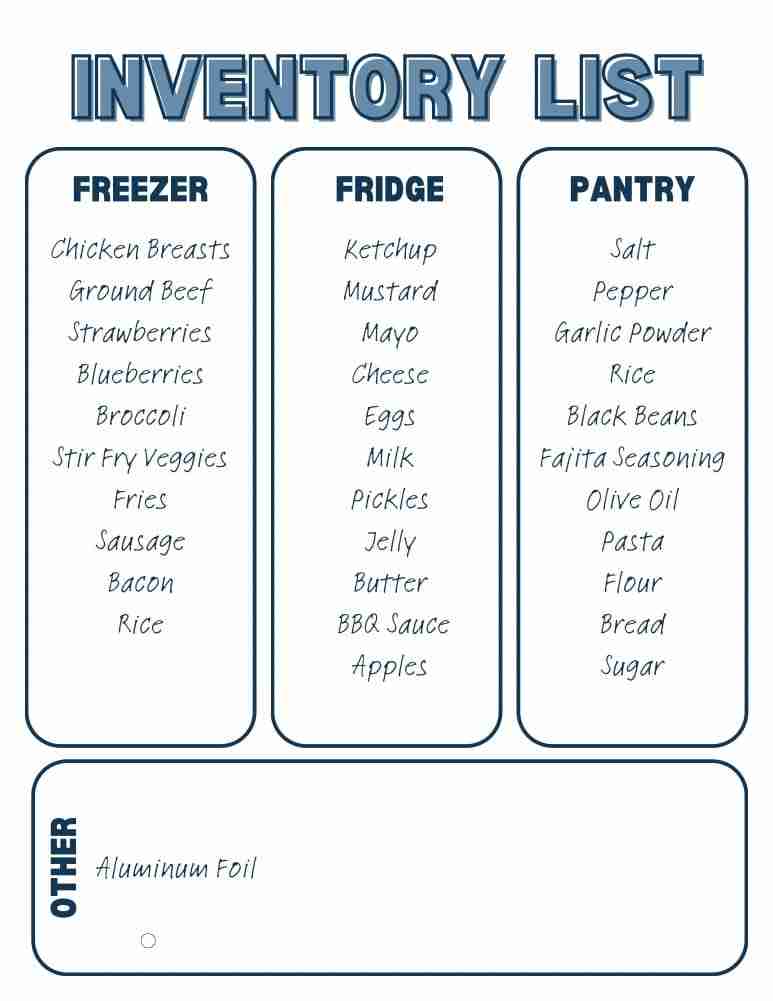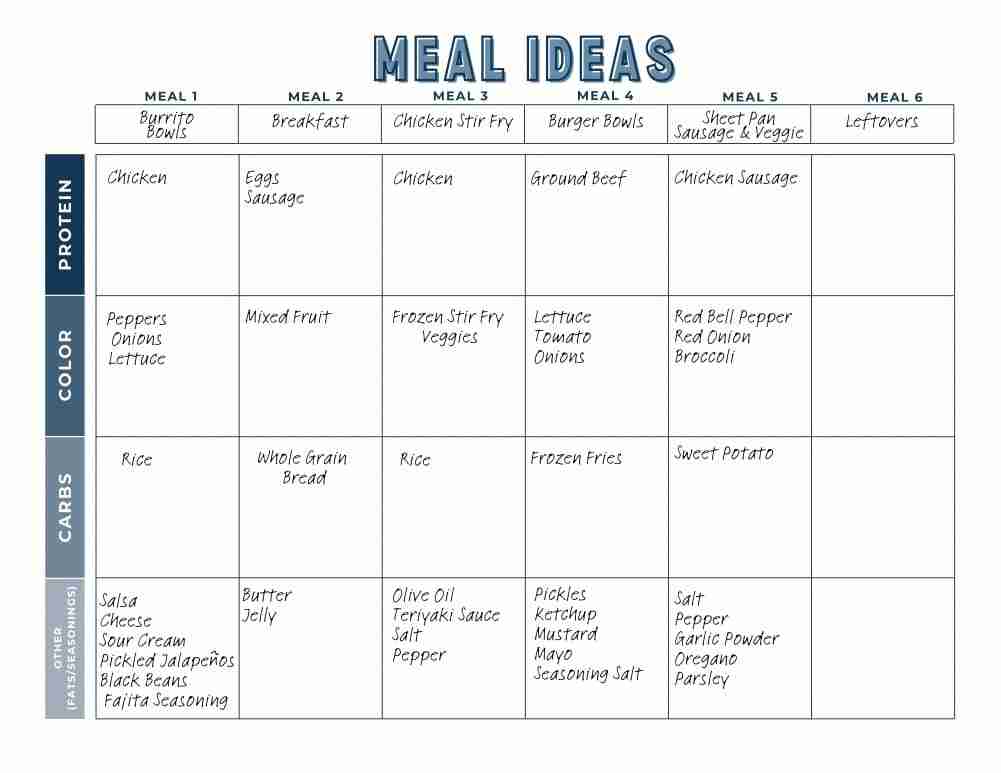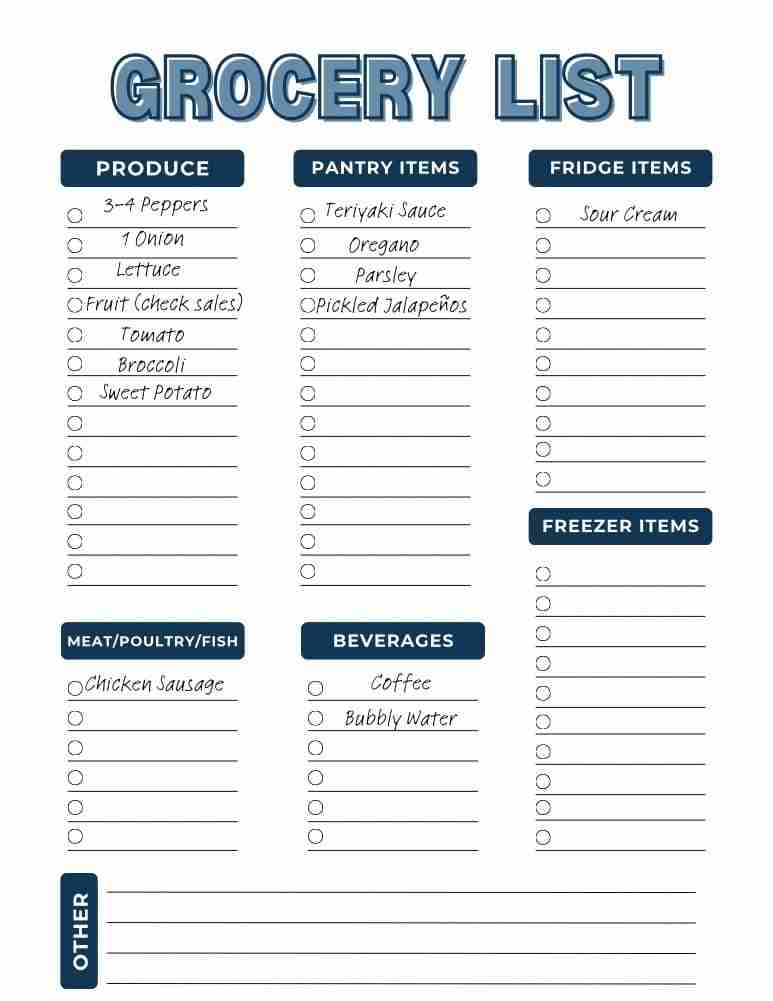It’s not news that grocery shopping has gotten more expensive in recent years. In 2022, food prices increased by 10.9%, and from August 2022 to August 2023, food prices rose by 4.3%. According to the USDA, food prices are projected to rise another 2.2% in 2024. Which is why I created this frugal meal planning guide, complete with a free printable workbook, to help your grocery budget.
Hey, I’m Jenn, a Registered Dietitian who has a passion for helping individuals fuel, think, and move towards the best versions of themselves without sacrificing their relationship with food. If you want practical, evidence-based nutrition advice to improve your performance and wellness — Learn how I can help.
This guide covers my frugal meal planning technique, including meal preparation, grocery shopping pointers, essential kitchen ingredients, and other helpful tips and resources.
Benefits of Meal Planning
Reduce Stress
After a long and stressful day, the last thing you want to worry about is what to make for dinner and whether you have all the necessary ingredients. By planning ahead and having the ingredients on hand, you can alleviate this stress and focus on relaxing at night. This frees up your time to do what you enjoy without worrying about meal prep.
Save Time
By implementing a meal planning strategy, you can save time and reduce stress throughout your week. With a solid plan in place, you’ll have a clear idea of what you want to prepare, the necessary ingredients, and prepped meal components, allowing you to streamline your cooking efforts and free up your schedule.
Save Money
Creating a meal plan also allows you to be more mindful of your meal choices and budget.
Research suggests that people who spend less than one hour per day on food preparation at home are less likely to spend money on eating out or fast food.
Reduce Food Waste
Planning your meals ahead of time can help you avoid buying excess food and reduce waste. By prepping perishable items – like fruits and veggies – you can easily incorporate them into meals and snacks, even when you’re short on time. Additionally, setting aside a night for leftovers can also help reduce waste, as it is one of the primary contributors to food waste.
More Variety and Balanced Meals
Meal planning is a simple yet effective way to improve the quality of your meals. Research has shown that planning meals leads to more nutritious and balanced meals being made at home. People who plan their meals are more likely to adhere to nutritional guidelines and consume a greater variety of food.
Studies have also found that meal planning leads to higher fruit and vegetable consumption. This is significant given that 90%of Americans do not consume the recommended amount of fruits and vegetables.
How to Start Frugal Meal Planning
Although it may seem overwhelming, beginning a frugal meal plan is simpler than you think. Having a plan and knowing you have everything you need can alleviate stress when it comes to cooking and healthy balanced eating.
Let’s dive into my frugal meal planning technique.
Set a Budget
To plan your meals effectively, you need to know how much you’re willing or able to spend on groceries each week or month. By setting a budget, you’ll have a clear idea of how much you need to allocate for food expenses and can plan your meals accordingly.
Take Inventory
Taking inventory of the items already in your pantry, fridge, or freezer can help avoid purchasing doubles (or triples) of an item. Knowing what you already have at home can help you plan your meals better, which can in turn save you money when you go grocery shopping.

Plan Out Recipes for the Week
Maximize your pantry and minimize food waste by selecting meals that share common ingredients, or by using ingredients you already have. Make sure to include a leftover night in your meal plan to avoid throwing away food.
When planning my meals, I like to keep them balanced and incorporate protein, color (fruits and vegetables), carbohydrates, and healthy fats.
To find recipes, check out social media or visit one of my personal favorite websites, Budget Bytes.
Budget Bytes offers a variety of tasty recipes designed for those who are on a tight budget. They also break down the cost of each recipe as well as the cost per serving.
Write Down ALL Ingredients
Next, I like to write down the ingredients for each recipe and then compare them with one another. This allows me to substitute ingredients with similar options from other recipes or with more affordable alternatives.
Then to avoid unnecessary expenses, I cross off any ingredients I already have on hand before making my grocery list.

Make the Grocery List
Next I make my final grocery list,. When making the list, I make life easier by categorizing each item. I divide items into categories such as:
- Produce
- Pantry
- Meat & Poultry
- Seasonings
- Beverages
- Eggs & Dairy
- Frozen
- Household items
- Random

Go Shopping
One technique that has been very helpful for me in cutting costs while shopping is to go after having a meal or snack. This small trick will help you maintain control while shopping.
I always say it is a good idea to leave a little wiggle room in your budget for a tempting item that catches your eye. This keeps grocery shopping fun and keeps you from feeling deprived of foods that sound good in the moment.
Put away and Prep Items for the Week
When you get home, put away all of your groceries and take a well deserved break.
After you rest, here are some effective meal prep tips that will help you save time during the week:
- Clean and cut your fruits and veggies (You are more likely to eat more fruits and veggies throughout the week when they are prepped.)
- Prepare any grains you can ahead of time (rice, quinoa, etc.)
- If you are having any salads throughout the week, prep your salad bases
- Cook any proteins ahead of time
- Make hardboiled eggs if included in the menu for the week
- Make muffins, energy bites, granola bars, protein sheet pan pancakes, etc.
- Prep lunches and snacks into containers so that you can grab and go.
By following these tips, you are able to take some of the stress out of cooking throughout the week.
Dietitian’s Tips for Frugal Meal Planning
Look for Coupons
Check directories and coupon pages to see if what you need is on sale. You can also see the individual products websites (i.e Bob’s Red Mill) to see if they have additional coupons
Shop Around
Look at the prices of what you plan to buy at a couple different grocery stores, especially more expensive items like meat and fresh produce. There’s a chance one of the stores will be running a promotion and have it for less.
Get Creative with Leftovers
Don’t let leftovers go to waste! Instead of throwing them away or eating identical meals multiple days in a row, get creative with repurposing them.
For example, leftover roasted chicken can become a delicious addition to salads, sandwiches, burrito bowls, quesadillas, or stir-fries.
Buy in Bulk
Buying ingredients you use a lot in bulk will end up costing less per serving.
I recommend bulk-buying staples like:
- Oats
- Nuts
- Beans
- Rice
- Quinoa
- Meats
- Frozen Fruits
- Frozen Vegetables
- Pasta
- Olive Oil
- Avocado Oil
Cook in Bulk and Freeze
Prepare large batches of meals that can be divided into individual portions and frozen for later use. This will save you time and money when you can simply defrost a meal if you’re in a rush or don’t feel like cooking.
Save with Seasonal Produce:
Eating fruits and vegetables that are in season can save you money and offer better flavor due to their freshness. Local produce that is in season is usually offered at a lower price point and can be incorporated into your meal plan accordingly.
To help you get started, use the USDA’s seasonal produce guide as a reference.
Consider Frozen or Canned Produce
Despite their reputation, frozen and canned fruits and vegetables are an excellent option for your meal planning needs. Not only do they have a longer shelf life, but they are also equally delicious and versatile. Just be sure to check the labels to avoid excess added sugar and salt.
Frozen produce is picked and frozen when it’s in its prime, making it surprisingly fresh and always in season.
Canned vegetables, on the other hand, are budget-friendly and have an extended shelf life, which can help you save money while reducing food waste.
Whether you opt for fresh, frozen or canned produce, you can rest assured that each option provides nutritional benefits.
Stay Flexible
Every day is different, and your appetite may vary. Some days you might prefer light meals, while other days you might crave something more substantial. Allowing yourself to eat what you want at the moment can help build a healthier relationship with food and prevent overeating later on.
Instead of following a strict meal plan, try planning meals for the week and choosing the one that best matches your appetite and cravings each day. By doing so, you will feel more connected to your body, reduce intense cravings, and enjoy your food more.
Final Thoughts
Meal planning can be a great way to save time, money, and reduce stress while also promoting healthy eating habits. Though it may seem daunting at first, following a simple 7-step meal planning technique can make the process much more manageable. By planning ahead, you can reduce food waste and streamline your cooking routine, making it easier to prepare balanced meals.
To make meal planning easier, I created a free frugal meal planning guide to help you streamline your meal planning.
Are you ready to stop stressing about your diet and learn realistic strategies that work? Schedule a free 15 minute call today!
Jenn Fink is a licensed and board-certified Registered Dietitian Nutritionist based in Minnesota. Her goal is to help busy people and families prioritize their health by living a balanced lifestyle and feed their families flavorful meals without spending hours in the kitchen. Jenn is passionate about all things food-related and enjoys making complex science easy to understand for her clients and readers.

